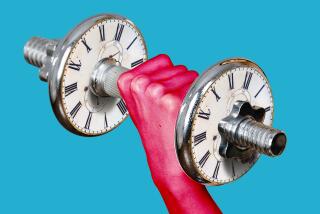Fit to Be Injured : Can you say <i> sore</i> ? That’s the term that describes many folks who rush to look like Jane or Arnold.
- Share via
Here we go again. The sun’s shining, the beach is beckoning and your bathroom mirror has spoken: You’re fit, all right--fit for Rush Limbaugh’s wardrobe.
In a panic, you make a beeline for the gym. Wait up for just a moment. In your quest for quads of steel, you may be en route to mistakes that can cause injury, gut the effectiveness of your workout and turn you off to the joy of a good sweat.
In 23 years as a trainer, Beth Rothenberg of Santa Monica has witnessed her share of amazing stunts at the gym.
“I’ve seen people bend over and pick up an unbelievably heavy barbell--their abdominals are hanging out, their back is overarched, their hand grip is too wide, and they’re pressing at the wrong angle. They’re really into what they’re doing, but my only thought is: ‘How are they going to feel tomorrow?’ ”
Here are 10 common errors made at the gym and simple ways to avoid them.
THE PROBLEM: GOING BONKERS.
“People get overenthusiastic,” says trainer Jon Jon Park of World Private Exercise in West Los Angeles. “They say, ‘I want to work out six days a week,’ and they want to incorporate every exercise they’ve ever seen. But three months later, they’ve killed their enthusiasm and they don’t come in anymore.”
The fix: Ease back into exercise. Start by working out three days a week, and don’t attempt to pick up where you left off four months--or four years--ago.
THE PROBLEM: NOT HAVING A PLAN.
“An architect has a blueprint, and a writer has an outline, but people are going into the gym totally scattered--it’s like a shotgun approach,” says Todd Person, owner of Metabolic Project, an L.A. gym. People fail to look at the big picture, whether their goal is to lose fat, tone their triceps or fit into a wedding dress.
The fix: Write down your goals. Rothenberg suggests defining three types of goals: long-term (six months to a year), short-term (one to three months) and daily. Ask a trainer to design a logical workout schedule.
THE PROBLEM: LIFTING TOO MUCH WEIGHT.
Look around your gym and you’ll catch people doing the “rock and roll”--rocking the entire body to gain enough momentum to roll up the weight.
“It’s the cheat method,” says Candice Copeland, a Mammoth Lakes fitness expert who trains personal trainers. “Rather than just work, say, your biceps, you’re working every other muscle in the body.”
The fix: Keep your ego out of it. You know you’re lifting the right amount of weight if your last two or three repetitions are tough, but not so challenging that you have to contort your body or grunt. You’ll get much better results if you use less weight and proper form.
Don’t go too light, however. “For some women, there’s still that fear that they’re going to bulk up,” Person says. “But you have to have ample resistance to make real changes in your body.”
THE PROBLEM: SPEED LIFTING.
When you lift weights too fast, you develop momentum, which, in turn, makes the exercise too easy on your muscles. “People don’t allow the muscle to fully contract,” Rothenberg says. People are especially lax on the return phase of a lift--they’ll hoist the dumbbells up slowly, then let them come crashing down.
The fix: Slow down. Take at least two seconds to lift, and then pause for a second or two at the top of the movement. “That allows the muscles to fully recruit all the little motor units,” Rothenberg says. “The extra squeeze at the top allows muscles to say, ‘Yeah, I got it.’ ” Take a full two seconds to return the weight to the starting position.
THE PROBLEM: NOT ASKING FOR HELP.
You might assume that the Titanic trainers at your gym have no life and no brain. You think, “He may have huge pecs, but I have a degree in French literature.” The fact is, they can help you.
“There’s staff in every gym, yet people don’t ask for help because they don’t want to look stupid,” says Los Angeles trainer Kathy Kaehler, the fitness expert for NBC’s “Today” show.
The fix: Don’t be a snob and don’t be shy. Just go up to a trainer and say, “I don’t have the faintest idea what I’m doing.” Don’t spend half an hour trying to figure out which way to sit on the abdominal machine or attempting to copy what other people are doing.
“Just because someone else is doing an exercise doesn’t mean it’s appropriate for your goals and needs,” Copeland says. “A deadlift might be perfectly OK for a competitive body builder, but you might wreck your back.”
THE PROBLEM: STARVING YOURSELF.
“Food isn’t the enemy,” Person says. Yet many people don’t grasp this. They come to the gym hungry and have no oomph. “If you don’t put gas in the car, it won’t go,” Park says.
People also skimp on post-workout meals, wrongly assuming that scarfing pasta primavera right afterward would negate everything they’ve gained on the StairMaster. They’re wrong.
The fix: Fuel and refuel. “Eat an hour before your workout, and within a half-hour after your workout,” Person says. That’s the window of time during which your body is most receptive to absorbing the nutrients you need to recover for your next workout. Experts recommend high-carbohydrate foods, such as a banana or a bagel. An hour and a half later, eat a meal that combines carbs and protein.
THE PROBLEM: DRESSING LIKE A CALVIN KLEIN UNDERWEAR MODEL.
“People think that in order to go to the gym, they need to wear a leotard, matching tights and a G-string,” Kaehler says. “But it’s not comfortable.”
The fix: “If you feel comfortable in a pair of tights and a crop top, that’s great,” Kaehler says. “But if you feel more comfortable in sweats and a T-shirt, that’s what you should wear.”
THE PROBLEM: NOT ADJUSTING THE MACHINES.
It’s everyone’s nightmare: You pull out a pin to adjust a weight machine, the wholething comes crashing down and everyone in the gym is staring at you. But things will be a lot worse if you don’t customize the machine to fit your body. If you’re 6 feet, 3 inches and the woman before on the chest press was 5 feet, 2 inches, you’ll feel like you’re trapped in a high chair.
“I see that, and it kills me,” Rothenberg says. “You can absolutely injure yourself.”
The fix: Practice, practice, practice. Don’t just have a trainer show you how to adjust each machine; make the trainer watch you do it. Practice on each gizmo two or three times. Write down which notch is the right one for your body. The same goes for adjusting the seat on the stationary bike.
THE PROBLEM: GETTING MARRIED TO YOUR ROUTINE.
“People do the exact same routine in the exact same order for years,” Person says. It’s comforting to master a certain group of exercises, but the problem is, your body adapts, and it’s no longer stimulated to make further gains.
“The muscle, like the mind, is going to get bored and switch off,” Park says.
The fix: Mix it up. Change your weight routine every six or eight weeks by learning different exercises for each body part. Change the angle of the bench; use a barbell instead of a dumbbell or machine; do the exercise standing instead of sitting.
“Each little nuance, each little change helps,” Rothenberg says. “Muscle loves surprises--that’s what it really, really responds to.”
THE PROBLEM: IMPATIENCE.
“Because we’re a visual society, we expect immediate gratification,” Person says. “Someone’s been working out for a week and their stomach’s still the same and they start to get frustrated.”
The fix: Give yourself time. Despite what some fitness magazines promise, you’re looking at 10 to 20 weeks to truly make gains--to firm up your muscles and get some definition. “It’s like building a house--you’ve got to lay down foundation,” Person says.
Adds Park: “It should be a gradual process, and people should enjoy the changes while they go through it.”


